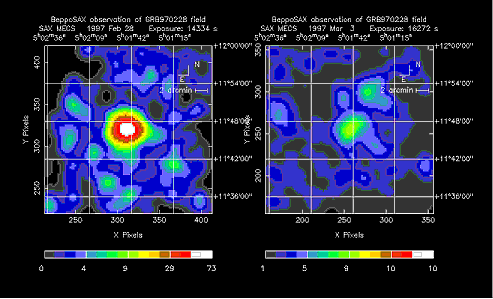Gamma-ray bursts
Since their discovery in 1973, Gamma-Ray Bursts (GRBs) have been one of the most intriguing mysteries in modern astronomy. Observations made using BATSE on CGRO and the detectors on BeppoSAX have revolutionized our understanding. The isotropic distribution of GRBs detected by BATSE was interpreted as evidence of extragalactic origin (Megan et al. 1992, Nature 355, 143). The conclusive breakthrough came with the discovery of a fading X-ray (Costa et al. 1997, Nature 387,783) and optical afterglow (Van Paradijs, 1997, Nature 368, 686) from GRB 970228 (Fig. 9). The few arcminute error circle from the BeppoSAX afterglow made possible the identification with a 25th magnitude dwarf galaxy at z ~0.835 -- confirming the cosmological nature of GRBs. More than twenty GRB afterglows have been followed by BeppoSAX, RXTE and ASCA, most of which are available at the HEASARC archive. The upcoming Swift and HETE missions will gather up to a thousand redshift measurements using afterglows and will most likely identify many different classes of GRB. The BATSE archive of several thousand bursts will be a valuable resource to retroactively classify and study the properties of GRBs.The BATSE archive of gamma-ray burst data has been a rich resource for research. Once the public archive was started, with the release of the BATSE 1B catalog of 260 bursts, the data were widely used to study the isotropy and homogeneity of bursts (e.g. Quashnock & Lamb 1993, MNRAS 265, L45). Currently the BATSE archive contains over 2500 bursts, and is large enough for study of different subclasses of bursts, characterized by apparent brightness, duration, spectra, or the shape of the burst profile. Archival studies of the distribution and the spectral and temporal evolution of bursts are numerous and ongoing. Selected recent examples are discussed below.

BeppoSAX observations of the first X-ray afterglow from GRB 970228 at 8 hr and 3 days after the GRB detection. These data are part of the HEASARC archive and this famous image was produced using the HEAsoft XIMAGE program.
Though individual burst time profiles are complex, and the overall distribution of bursts is known to be isotropic but not uniform, Cline et al. (1999, ApJ 527, 827) find that the shortest-duration bursts have a Euclidean brightness distribution and therefore could be local. Bonnell & Norris (2000, ApJ submitted) have shown that an apparently homogeneous distribution for bursts with no emission detected above 300 keV is due to brightness bias in detection of bursts by BATSE.
The high time resolution of the BATSE data allows the detailed examination of time profiles in a large sample of bursts. Scargle (1998, ApJ 504, 405) presented a promising model-independent method for the attributes of pulses in BATSE bursts. Beloborodov et al. (2000, ApJ in press) found that the brightnesses of bursts is correlated with the slopes of their power density spectra, which implies that bursts are not standard candles. Ramirez-Ruiz & Fenimore (1999, A&AS 138, 521) find the widths of pulses in time profiles of bursts remain constant between pulses. This limits the amount of deceleration of the expanding fireball during a burst, and constrains any model of the emitting regions.
Spectral characteristics of bursts studied by Lloyd & Petrosian (1999, ApJ 511, 550) suggest that BATSE may be detecting only a small fraction of a population of hard, high-energy bursts and that the rate of bursts at cosmological distances may be different from the star formation rate.
Studies of afterglows of gamma-ray bursts have shown that the bursts occur at cosmological distances. The potential for gamma-ray bursts to be used as a probe of dark matter was recognized by Marani et al. (1999, ApJ 512, L13), who searched BATSE data for evidence of gravitational lensing of bursts. For massive lensing objects, stringent upper limits on the abundance were found.
For bursts with redshifts (and hence luminosities) well-determined from followup observations of afterglows, Norris et al. (2000, ApJ, in press) have found a remarkable relation between spectral evolution, specifically the energy dependence of the cross-correlation lags, and luminosity. In addition to offering clues to the physics of bursts this relation allows luminosity estimates for bursts that otherwise would have unknown redshifts.
|
Cataclysmic Variables |
Science Introdution |
The WGA Catalog of ROSAT Sources |
